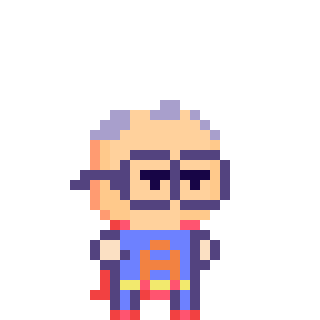
Dismedia
"You have brought me to what I hate most! You have incited me to use the devices I always rejected!..."
- Carl Lang, Dismedia

Dismedia is a project in development made in Unity, which began as part of my final project for my Bachelor's Degree in Communication Sciences . It is a Puzzle/Platform mobile game with 2-D Pixel Art aesthetics.
The main character is Carl Lang: a man dressed as Superman with an “A” on his chest who seeks to escape from a world characterized not only by elements of mass culture, but also by our digital reality, using the same elements that this world offers him to his advantage. What Carl doesn’t know is that this journey will help him overcome the traumas he has been carrying around throughout his life.
Main Mechanics
Horizontal movement
This mechanic also allows objects to be moved to the same side of the movement, after colliding with them.
Hop


These mechanics, when related to the rules of the Environment, allow for the creation of the dynamics of evasion , but also of stacking objects, using them as platforms to reach up and try to escape ( see below ).
The design of the rules, mechanics and gameplay were conceived in order to convey the following main idea: it is absurd to reject the inexorable, to try to obsessively fight against a chimera, and therefore, the only possible escape is to simply accept , albeit critically, the world in which we find ourselves .
And it seeks to evoke a feeling of confinement or minimal freedom .
A more detailed analysis of this can be found in Press Start for Articulating Communication Sciences and Video Game Design .
Progression and Pacing

The game begins with an introduction to the plot. At first, not much is told, but as the story progresses, everything will begin to make sense. This narrative progression is characterized by the linear sequence of events, typical of a comic book format.

Level 1. The Great Dictator
The first level only shows the objective, a defeat condition, and the mechanics. The temporal rhythm is marked by a relaxation, in that the action potential of the person playing is greater than the event potential of the Game Environment. That is, there are no events in the Environment to which the player must adapt.
Level 2. King Kong (1976)
In the second level, on the one hand, you can already see that there are specific objects that you can interact with - drag the pink TV -. At this point, you understand that you can stack them. On the other hand, in addition to maintaining the first defeat condition, you also learn that there are objects that fall and that, in turn, you have to prevent them from falling on top of the character.
The Environment also accompanies the actions of the player, so there is a balance between actions and events.


Level 3 . ET, the Extraterrestrial
With all this prior information about the rules, the third level begins.
Here, it is much more likely that the person playing will have more difficulty in achieving the objective, since the Environment does not accompany his actions, but rather he must adapt to the pattern. Thus, in this last level of the DEMO, we can see the beginning of the increase in playful tension.
As you progress through the levels, the difficulty curve increases. This promotes not only a narrative progression, but also a playful one. The design of this ludic-narrative progression allows the rules of the Environment to be gradually taught, as well as what the person playing must do, so that the information is not given all at once, but in a smooth and staggered manner.
Final Evaluations
Regarding the game, while advancing through levels and unlocking new narrative events is both a reward and a clear measure of progression for the player, other features are needed to reinforce motivation. A points system that functions as a currency—exchangeable for relevant items such as comic pages that enrich the lore and/or cosmetics that offer greater customization—would be worth implementing, and it would also support the game’s concept.
Likewise, further polishing is needed. For example, progressing to the next level isn’t entirely clear yet, so some signposting is necessary to indicate that, once at the top, the player needs to jump.
As for my learning process, I’ve understood how essential it is that design decisions aimed at evoking specific emotions or aesthetics (MDA) be accompanied by a decision about what you want to communicate, to strengthen a game’s cohesion and coherence. In other words, being very clear about the content or values we want the work to convey allows us to plan and exert greater control over the potential meaning of every detail in the game, so that players arrive at the interpretations we intend.
A more detailed analysis of this can be found in Press Start para articular Ciencias de la Comunicación y Diseño de Videojuegos.